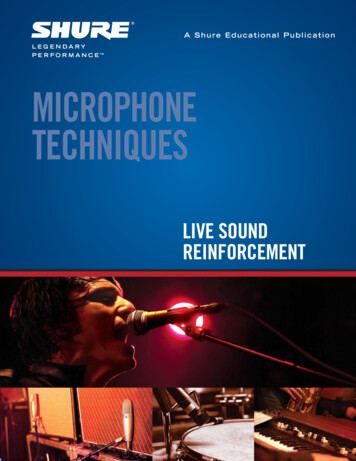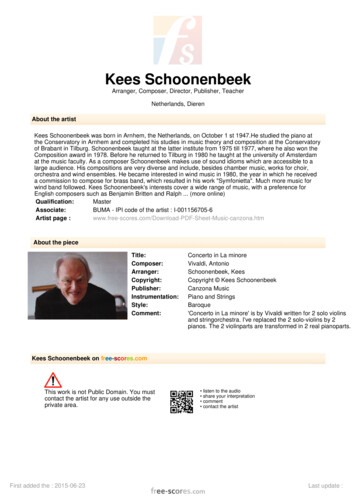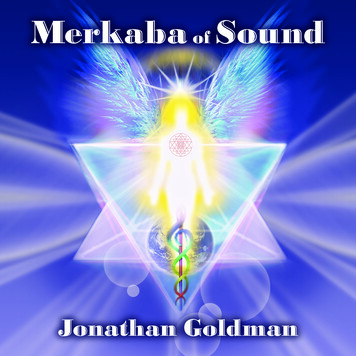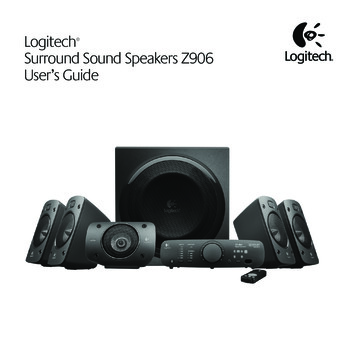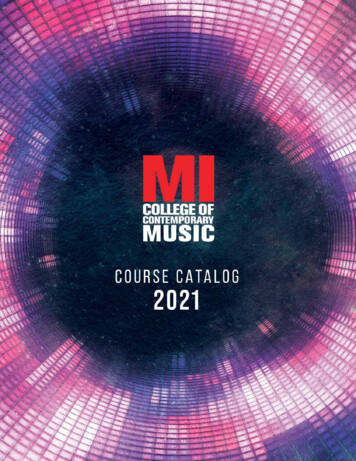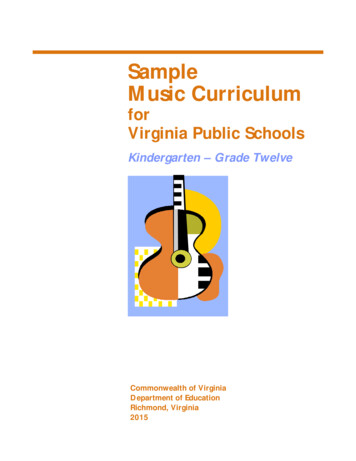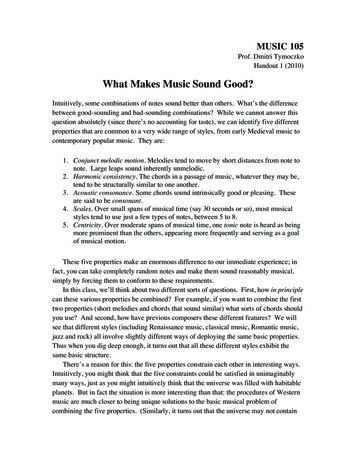
Transcription
MUSIC 105Prof. Dmitri TymoczkoHandout 1 (2010)What Makes Music Sound Good?Intuitively, some combinations of notes sound better than others. What’s the differencebetween good-sounding and bad-sounding combinations? While we cannot answer thisquestion absolutely (since there’s no accounting for taste), we can identify five differentproperties that are common to a very wide range of styles, from early Medieval music tocontemporary popular music. They are:1. Conjunct melodic motion. Melodies tend to move by short distances from note tonote. Large leaps sound inherently unmelodic.2. Harmonic consistency. The chords in a passage of music, whatever they may be,tend to be structurally similar to one another.3. Acoustic consonance. Some chords sound intrinsically good or pleasing. Theseare said to be consonant.4. Scales. Over small spans of musical time (say 30 seconds or so), most musicalstyles tend to use just a few types of notes, between 5 to 8.5. Centricity. Over moderate spans of musical time, one tonic note is heard as beingmore prominent than the others, appearing more frequently and serving as a goalof musical motion.These five properties make an enormous difference to our immediate experience; infact, you can take completely random notes and make them sound reasonably musical,simply by forcing them to conform to these requirements.In this class, we’ll think about two different sorts of questions. First, how in principlecan these various properties be combined? For example, if you want to combine the firsttwo properties (short melodies and chords that sound similar) what sorts of chords shouldyou use? And second, how have previous composers these different features? We willsee that different styles (including Renaissance music, classical music, Romantic music,jazz and rock) all involve slightly different ways of deploying the same basic properties.Thus when you dig deep enough, it turns out that all these different styles exhibit thesame basic structure.There’s a reason for this: the five properties constrain each other in interesting ways.Intuitively, you might think that the five constraints could be satisfied in unimaginablymany ways, just as you might intuitively think that the universe was filled with habitableplanets. But in fact the situation is more interesting than that: the procedures of Westernmusic are much closer to being unique solutions to the basic musical problem ofcombining the five properties. (Similarly, it turns out that the universe may not contain
so many planets that can sustain life, much to the disappointment of science fictionauthors.) For instance, if you want to combine conjunct melodic motion with harmonicconsistency, it turns out you need to use the acoustically consonant chords of traditionalWestern music: major triads, dominant seventh chords, and so on.For essentially similar reasons, much Western music has a kind of hierarchical selfsimilarity, with the behavior of scales mirroring that of chords. In many Western styles,it is common to switch scales—for instance, the opening section of a piece might use thewhite notes C-D-E-F-G-A-B while the next section uses the G major scale G-A-B-C-DE-Fs. We can understand this process by saying that the note F moves up to Fs by a shortdistance. This is basically the same thing that happens when one chord moves to another,though now on the level of the scale rather than the chord.The ultimate purpose of this course is twofold. First, I want you to develop fluency ina range of styles from medieval music to contemporary rock. The point here is to have asense for all the different ways in which Western composers make music, and not get too“locked in” to any one way of doing things. You might come to this class fluent only inclassical music, or jazz, or rock, but I want you to leave with a reasonable understandingof all three styles. Second, I want to understand the deeper similarities between thesesuperficially different-sounding musics—the “hidden roads” them. Ultimately, it’s notenough just being able to imitate a bunch of different musical procedures, like a robotexecuting a series of pre-programmed dance steps. I’d also like you to understand whythese practices are the way they are.
MUSIC 105Prof. Dmitri TymoczkoHandout 2 7FG1. Pitch and pitch class. A pitch is a specific note, like middle C or the G a perfect fifthabove it. A pitch class is a note type, like “C” or “G”—it’s what we end up with whenwe ignore what octave pitches are in. Pitches live on a line, while pitch classes live on acircle. (Pitch is like time, whereas pitch class is like time-of-day.) Note Western musicdivides the pitch-class circle into 12 units, just like an ordinary clock, meaning you’renever far from a model of pitch-class space.2. Naming pitch classes. We have two systems for naming pitch classes: letters andnumbers. Letters came first, and only the white notes have their own letter names. Theblack notes (like Cs) have to be named relative to some other pitch class. Note that everypitch class has an infinite number of letter names: C, Bs, Asss, etc. By contrast, in thenumerical system every pitch class has a unique name (C 0, Cs/Df 1, D 2, etc.).We can assign names even to pitch classes not found on the ordinary piano keyboard (forinstance, the pitch class 2.5 is halfway between D and Ef.)3. Naming pitches. We can use a similar system to label pitches: the most commonmethod, scientific pitch notation, combines a letter name with a number indicating whatoctave a note is in; middle C is given the octave number 4, as are all notes less than anoctave above it. NB: accidentals are applied after the letter and number are combined togenerate a pitch: the note just below middle C can be labeled either B3 or Cf4!Similarly, C4 can also be called Bs3! This is terribly confusing but there it is.
It is also possible to use numbers to label pitches. Here middle C is given thenumber 60, the Cs above that is 61, the D above that is 62, and so forth. To go frompitch numbers to pitch class numbers divide by 12 and keep only the remainder.middle CC236C348C4E4B3or Cf4 (NOT Cf3!)59 6064C5(letter names)B471 72(number names)4. Naming intervals. An interval is a musical distance. Intervals can be named relativeto letter names and relative to pitch numbers. Numerical pitch labels are the simplest, butthey are less commonly used: the interval between middle C (C4, pitch number 60) andthe D immediately above it (D4, pitch number 62) is two ascending semitones. Theinterval between D4 (62) and G3 (55) below it is seven descending semitones. Intervals inthis sense are sometimes called “chromatic intervals” or “chromatic semitones.” To findthe interval between two notes just count keys on a keyboard, or frets on a guitar, or Unfortunately, the most common way to talk about musical distance (intervals) isa letter-based system. Strictly speaking, this system is defined only for notated music.We cannot identify the interval between two notes just by listening. However, there are aset of common conventions for notating music that typically make it possible to guess thecorrect letter-name interval, merely by listening.The interval between interval between any C (such as Cs4 or Cf4) and any Dimmediately above it (such as Ds4) is called an ascending second. Believe it or not, thisis because C and D are one letter name apart. Similarly, the interval between any C andany form of the E immediately above that is called an ascending third–again, becausethey are two letter notes apart. Note that a second is not necessarily smaller than a third:the interval C–Ds is an augmented second, which is larger than the interval Cs-Ef, adiminished third. See the table at the end of this handout.5. Registral inversion. The (registral) inversion (or complement) of an interval is theinterval formed by transposing the top note down by octave until it is the bottom note.For instance, C4-E4 is a major third; transposing the E down an octave, we get itsinversion, E3-C4, a minor sixth. An interval and its registral inversion always make upan octave. Inversion transforms major into minor and perfect into perfect: thus the minorthird becomes the major sixth and the perfect fifth becomes the perfect fourth.
Letter NameDistance0 (e.g. C-C)unison1 (e.g. C-D)second2 (e.g. C-E)third3 (e.g. C-F)fourth4 (e.g. C-G)fifth5 (e.g. C-A)sixth6 (e.g. C-B)seventh7 (e.g. C-C,an octaveabove) octaveChromatic DistanceNameAbbreviation-1 semitones (C-Cf)0 semitones (C-C)1 semitone (C-Cs)0 semitones (Cs-Df)1 semitone (Cs-D)2 semitones (C-D)3 semitones (C-Ds)2 semitones (Cs-Ef)3 semitones (Cs-E)4 semitones (C-E)5 semitones (C-Es)4 semitones (C-Ff)5 semitones (C-F)6 semitones (C-Fs)6 semitones (C-Gf)7 semitones (C-G)8 semitones (C-Gs)7 semitones (Cs-Af)8 semitones (C-Af)9 semitones (C-A)10 semitones (C-As)9 semitones (Cs-Bf)10 semitones (C-Bf)11 semitones (C-B)12 semitones (C-Bs)11 semitones (C-Cf)12 semitones (C-C)13 semitones (C-Cs)diminished unisonunison (or perfect unison)augmented unisondiminished secondminor secondmajor secondaugmented seconddiminished thirdminor thirdmajor thirdaugmented thirddiminished fourthperfect fourthaugmented fourth (tritone)diminished fifth (tritone)perfect fifthaugmented fifthdiminished sixthminor sixthmajor sixthaugmented sixthdiminished seventhminor seventhmajor seventhaugmented seventhdiminished octaveoctave (or perfect octave)augmented m7M7A7d8P8A8Additional Rules1. an interval one chromatic semitone smaller than a diminished interval is“doubly diminished”; an interval one semitone larger than that is “triply diminished,” etc.2. an interval one chromatic semitone larger than an augmented interval is“doubly augmented”; an interval one semitone larger than that is “triply augmented,” etc.3. after the octave comes the ninth, tenth, eleventh, and so forth. So the intervalfrom C4 to Ef5 is a minor tenth.I’ve used ascending intervals here; descending intervals work the same way.
6. Bonus fact. One can use the same system to identify rhythms. For instance, we canlabel the beats in a piece using numbers, and we can use a circle to represent the beats ina repeating measure.12ã 8 œ. œ. œ Œ œ œ. œ. œ Œ œ0or: 0336610 12 1510 0 31862210ã œ œ œJ œ œ œ Jœ œ œ Jœ œ œ œ Jœ0 2 4 5 7 9 11 0 2 4 5 7 9 11If you do this, you discover some interesting things. For instance, the major scale, 0-2-45-7-9-11 in numerical pitch-class notation, is a very common rhythm in Africa! (Why isthis?) Musically, this means that we can translate various compositional ideas betweenthe pitch domain and the rhythmic domain—for example, composers like Steve Reich useanalogues to traditional modulation!
MUSIC 105Prof. Dmitri TymoczkoHandout 3 (2010)Chords, chord-types, and CounterpointBCCs/DfDAD s /E fAs/Bf1. Chord. Ordinary terms such as “C major chord” refer to pitch classes rather thanpitches. When we say that a collection of notes is a C major chord we mean that itcontains the notes C, E, and G in any octave. Sometimes these notes might be played atthe same time, and sometimes they might be played one right after each other. In thelatter case, it doesn’t matter which note comes first. It follows that we can model chordsas an unordered collection of pitch classes, represented geometrically by an unordered setof points on the circle. For instance, the C major chord is the set {C, E, G} representedby the following points:FAfs/EFs /GfGGBCCs/DfDAD s /E fAs/Bf2. Chord types and transposition. To transpose a passage of music is to move everynote by the same distance. Transposition is important because it preserves the structureof a chord, or in other words the distances between its notes. This means thattranspositionally related chords sound similar. (In fact, most musicians cannot tell a Cmajor chord, played on Monday, from a D major chord played on Tuesday—people whocan do this have absolute pitch; the rest of us are stuck with relative pitch.)Transposition is represented geometrically by rotation in the pitch class circle, asillustrated by the following:FAfs/EFs /GfGG
All major chords are related by rotation/transposition; all minor chords are related byrotation/transposition; all dominant sevenths are related by rotation/transposition; etc.We can say that two chords belong to the same chord type if they are rotationally related.3. Counterpoint. Counterpoint is the art of combining multiple melodies to form a seriesof meaningful chords. It is a central ingredient of Western music.Suppose you would like to write music that uses a collection of similar soundingchords. (For our purposes, we can take “similar sounding” to mean “transpositionallyrelated.”) This means you want to use chords that are related by rotation on the circle.But you also want to connect the chords so that no chord moves by very much, so that thetransition can be represented as a series of structurally similar melodies. In other words,you want to find a pair of chords that are related in two ways: first, by rotation on thepitch class circle (so that they sound similar), and second by a short-distance mappingthat moves the notes of the first chord to those of the second?How is this possible? The answer is that this works best if we have a chord thatdivides the octave nearly evenly. This means that the notes of the first chord never haveto move far to get to the second.œœ& œœBœCCs/DfDAD s /E fAs/Bf?œFAfs/EFs /GfGG
MUSIC 105Prof. Dmitri TymoczkoHandout 4 (2010)Basic Musical Acousticsair pressure1. Sound. Sound consists in small fluctuations of air pressure, akin to the changes inbarometric pressure familiar from the weather report. These fluctuations are heard tohave a definite pitch when they repeat themselves (at least approximately) after someperiod of time t.t cycle durationtimeThe reciprocal of the period, 1/t, is the fundamental frequency of the sound—a numberthat measures how many repetitions of the pattern occur per unit of time. (Fundamentalfrequencies are labeled in cycles per second or Hertz.) Most musicians, lacking absolutepitch, are not sensitive to the absolute frequency of individual sounds: instead, they aresensitive to the ratios between fundamental frequencies. Suppose, on Tuesday, someonewhistles a tune whose successive pitches have frequencies f, g, h, On Wednesday, ifasked to reproduce the same tune, she is likely to whistle notes whose frequencies are cf,cg, ch, , where c is some arbitrary number (typically close to 1). Musicians say that thewhistler has transposed the tune: she has changed each of its fundamental frequencies ina way that preserves the ratios between them. This suggests that the ratio represents akind of musical distance, and that listeners are attuned to the distances between notesrather than their absolute positions in frequency space.It turns out that the ratio 2:1 corresponds to the octave. (If a note has frequency f,then 2f is the note an octave higher.) The ratio 3:2 is the perfect fifth, 4:3 is the perfectfourth, 5:4 is the major third, and 6:5 is the minor third. It is actually somewhat awkwardto work with ratios and fundamental frequencies: multiplication and division can beconfusing, and 110, 220, and 440 but not 330 all represent the note A . For that reason,musicians often use the numbering system we learned about in the last class.
2. The origins of consonance and dissonance. Certain chords, such as perfect fifths andmajor triads, sound stable and restful, or consonant, while other sonorities, such as thechromatic cluster {C, Cs, D}, sound unstable and harsh, or dissonant. Most Westernstyles exploit this difference: consonant sonorities tend to appear as musical destinationsor points of rest, while dissonant sonorities tend to be more active and unstable.Dissonance is the spice in the musical stew.The eighteenth-century mathematician Jean-Baptiste Fourier showed that anyperiodic waveform can be represented as the sum of sine waves whose frequencies areinteger multiples of its fundamental frequency f.Figure 1. The periodic sound on the left has frequency f. (Two repetitions of the waveare shown.) It can be analyzed as the sum of the sine waves on the right, with periods f,2f, and 6f. (These repeat twice, four times, and twelve times in the same horizontalspace.)When the periodic function represents a musical sound, these waves are called overtones,partials, or harmonics.The nineteenth-century German psychologist Hermann von Helmholtz proposedthat two pitches are heard to be consonant if their overtones are aligned, or else aresufficiently far apart from each other so as not to interfere. Dissonance is caused whenovertones are close together, but not perfectly aligned; this creates a sense of“roughness” or harshness. (Twentieth-century auditory physiologists have shown that theear’s basilar membrane decomposes incoming soundwaves into overtones, more-or-lessas Fourier described.) Though there is disagreement about just how complete this storyis, most contemporary psychologists believe that it is at least partly right.Most Western instruments produce “harmonic” sounds that, when analyzed asFourier described, have relatively strong lower overtones f, 2f, 3f, 4f. The overtones ofseveral of these sounds will match when their fundamental frequencies are related bysimple whole-number ratios. Consequently, as Pythagoras discovered roughly 2700 yearsago, pairs of harmonic tones will be particularly consonant when their fundamental
frequencies are approximately in simple whole-number ratios such as 3:2 or 5:4. Groupsof tones will be consonant when their fundamental frequencies are all mutually in simpleinteger ratios: chords such as 3:2, 5:4:3, 7:6:5:4, 9:8:7:6:5 and so on. However, if ourinstruments produced different overtones, then we would hear different intervals asbeing consonant!3. On the piano, the consonant chords divide the octave nearly but not perfectlyevenly. Here are some of the most consonant chords, of sizes two through seven. Alldivide the octave nearly-but-not quite exactly evenly.Notes{C, G}{C, E, G}{C, Ef, G}{C, E, G, A}{C, E, G, Bf}{C, E, G, B}{C, D, E, G, A}{C, E, G, Bf, D}{C, D, E, F, G, A}{C, E, G, Bf, D, Fs}{C, D, E, F, G, A, B}{C, D, E, Fs, G, A, Bf}NamePerfect fifthMajor triadMinor triadMajor triad “add six”Dominant seventh chordMinor seventh chordPentatonic scaleDominant ninth chordDiatonic hexachordDominant “sharp eleven”Diatonic scaleMelodic minor ascendingThe mathematical reason for this is slightly complicated. It’s related to the fact that,when we think in terms of fundamental frequencies, the perfect fifth and the major triaddivide the octave exactly evenly: the note 330 Hz (E4) divides the octave between 220Hz (A3) and 440 Hz (A4) into two equal (110-Hz-sized) parts. (Note that E4 is a perfectfifth above A4.) Similarly, the A major triad 330 Hz (E4), 440 Hz (A4), and 550 Hz(Cs5) divides the octave between 330 Hz (E4) and 660 Hz (E5) into three equal (110-Hzsized pieces). It turns out that when we go from fundamental frequencies to ordinarynote labels, we transform perfectly even divisions into nearly even divisions.4. The deep fact. The basic sonorities of Western music, such as perfect fifths, majortriads, dominant seventh chords, and so on, turn out to be important for two distinctreasons. Considered as individual sonic objects, they are acoustically consonant, andhence sound pleasing in their own right. But since these chords divide the pianokeyboard octave nearly evenly, they are also ideal for combining harmonic consistencywith conjunct melodic motion—as discussed in an earlier lecture!
5. Bonus mathematical fact. As we learned last time, we can name pitches by labelingthe keys of the piano. Here A3 ( 220 Hz) is 57, A4 ( 440 Hz) is 69, A5 ( 880 Hz) is81, and so on. With fundamental frequencies we multiply by two to ascend by octave;with numerical pitch notation, we add twelve. To convert from a multiplication-basedsystem to a addition based system, we use logarithms. In this case, the equation is:p 69 12log2 (f/440)or to go the other wayf 440 ! 2(p – 69)/12Here, f is a note’s fundamental frequency, and p is the numerical pitch label. In general,addition and subtraction are easier than multiplication and division, which is whymusicians prefer numerical pitch labels to fundamental frequencies.
!"# %&'()!"# %&!'()*#)! ,( -./ !0123 4*!5!67898:!!#* ,-&'.&# !/,-&!-0 -12,&%3"4*-5/3 4*!!;4#!%)# *!(4 )-1 ! *, !) !( 3 3!1%* #!*? ! 1# ) *! @1(A ! %!B * #2!- 42* #A )2*C!*? !*D !E )- !99*?F- 2*4#,! @1(A !% 423!)2!*? !* @*!!"# %&'()*# ',-.(")*!6G0 D!* !(1/ !- 42* #A )2*H:&!! ? !)2 *#4-*) 2 !I D! 2-1A 4 1* !6( # ! #! J:!*? !-4**)2KF 3K !#13)-1 !(4 )-!*?1*!D1 !I )2K!(13 !9888!, 1# !1K J!!!! 6&/789:6!! ? ! 2 ,!2 * !1 D 3!1# !*? ! E 2!D?)* !2 * !123!L!&!! 6&5:;8: 6! ? !(4 )-! ? 4 3!I !D#)** 2!)2!1! * 13,M!42-?12K)2K!#?,*?(M!D)*? 4*!# * &!!N 4!-12!2 *1* !)*!)2! )*? #! %!*D !D1, C!6':! 2!*D ! *1E !4 )2K!D? !2 * !% #! 1-?!E )- O! #!6/:M!% D)2K!*? ! @1(A !I DM! 2! 2 ! *1%%!D)*?! 2 !E )- !)2!D? !2 * !123!*? ! *? #!4 )2K!%) 3F)2!2 * ? 13 &!! ? !(4 )-! ? 4 3!I !3)E)3 3!)2* !A?#1 M! %!1AA# @)(1* ,!5F98!2 * &!! ?) !) !* !1 D!% #!1! )K?*!A14 !% #!I# 1*?!1*!*? ! 23! %! 1-?!A?#1 &!!'#1D!1!I1#! )2 !I *D 2!A?#1 &!! 6&1 79 ?&@AB&C@AD ?6!!B#)* !% #!*D !E )- ! )2K)2K! )(4 *12 4 ,M!)2!A# -) ,!*? ! 1( ! * 13,M!42-?12K)2K!#?,*?(&!!;I #E !*? !% D)2K!#12K C!!P A#12 C!QR!!!S5! T * C!SU!!!Q5! 2 #C!QU!!!SR!L1 C!S7!!!QR!!N 4!-12!D#)* !% #!12,!A1)#! %!E )- ! @- A*! A#12 !123!I1 &!!6V2!A1#*)-4 1#M!, 4!-12!D#)* !% #M! &K&M!*D ! A#12 &:!!V2!K 2 #1 M!E )- ! ? 4 3!I ! !*?12!12! -*1E !1A1#*&!!01.2#31 )4"#(.5.%#/.#* %.#61'(#'(# ,6'5.#'("#'# - 61#'7'%68!! 16&% EA8 CF 7A86!;I #E !*? !% D)2K!#4 C!9& W1-?!E )- ! ? 4 3!( E !( * ,!I,! * A&!!7& X 1A ! %!( # !*?12!1!%)%*?!1# !2 *!1 D 3&!U& Q 2 -4*)E ! 1A !)2!*? ! 1( !3)# -*) 2!(4 *!I *?!I !*?)#3 O!2 !( # !*?12!*D !)2!1!# D&!R& Y )- !-122 *!( E !I,!*#)* 2 &!5& "1#1 ! -*1E !123!42) 2 ! ? 4 3!I !4 3! 2 ,!E #,! --1 ) 21 ,M!123!*? # ! ? 4 3!2 E #!I !( # !*?12! 2 !A1#1 ! -*1E !6 #!42) 2:!- 2 -4*)E ,&!!!Z& N 4! ? 4 3!*#,!* !(1/ ! 4# !, 4#!*D !E )- !1# !# 1 21I ,!)23 A 23 2*C!*?1*!) M!*? ,! ? 4 3!2 *!( E !)2!A1#1 !% #!( # !*?12!*?# !- 2 -4*)E !2 * &![& Y )- ! ? 4 3!-# ! 2 ,! --1 ) 21 ,!\& W1-?!E )- ! ? 4 3!(1/ !1!K 3!( 3,M!D)*?!1!- 1#!?)K?!A )2*M!3 )2 1*)2K!1! A -)%)-!# K) * #! %!2 !( # !*?12!12! -*1E M! *-&!
!"# %&'()*"!!"# %&'()*!(&%! &,-.%/!0# ,! 1&%%!2)(**%*3!.%&4%2 !2,#*,#(#2%*5!06.%&4%2 !2,#*,#(#2%*5!(#/!/0**,#(#2%*7!!81&(*%*!6-* !9% 0#!:0 1!(!.%&4%2 !2,#*,#(#2%!(#/!%#/!:0 1!%0 1%&!(!-#0*,#!,&!(#!,2 ('%7!!"6.%&4%2 !2,#*,#(#2%*!(&%!.%&60 %/!,#);!0#! 1%!60//)%!,4! 1%!.1&(*%7!!"6.%&4%2 !2,#*,#(#2%*!*1,-)/!9%!-*%/!*,6%:1( !*.(&0# );5!1,:%'%&3! 1%;!:%&%! 1,- 1 ! ,!9%!*,6%:1( /0**,#(# !*,-#/*! 1( !(//! *.02% ! ,! 1%!6,&%!* (9)%!.%&4%2 !2,#*,#(#2%*7!! !-#0*,#!?,&!,2 ('%@5!.%&4%2 !4,-& 1!?,&!.%&4%2 !2,#*,#(#2%!%)%'%# 1@5!.%&4%2 !404 1!?,&! :%)4 1@! 10&/!?,&! %# 1@5!*0A 1!06.%&4%2 !2,#*,#(#2%!*%2,#/5!*%'%# 15!(- 6%# %/!4,-& 1!?,&!/0**,#(#2%!%)%'%# 1@5!/060#0*1%/!404 1!?,&! :%)4 )/!%#/!:0 1! 1%! :,!',02%*!6,'0# !9;!* %.5!0#!2,# &(&;!6, 0,#5! ,!(!-#0*,#!,&!,2 ('%7!!BA(6.)%3! %#,&!6,'%*!4&,6!CD! ,!EF5!:10)%!() ,!6,'%*!4&,6!GF! ,!EF7!!H&3! %#,&!6,'%*!4&,6!GF! ,!EF!:10)%!() ,!6,'%*!4&,6!CF! %! 1%!#, %!C!! ,!(',0/! 1%! &0 ,#%!9% :%%#!K!(#/!C7!!C%!2(&%4-)!(9,- ! 1%! &0 ,#%!9% :%%#!B!(#/!C!5!1,:%'%&L!!J,-!*1,-)/!#%'%&!1('%! :,!2,#*%2- 0'%!21,&/*5!,#%!:0 1!(!C"!(#/! 1%!, 1%&!:0 1!(!C!7!!M10*!0*!2())%/!(! 2&,**!&%)( 0,#7 !!!666"#:;&// (,./#.(2)3/& (,)3"!" !0*!()*,!.,**09)%! ,!-*%! 1%*%!&-)%*! ,!:&0 %! 1&%%!',02%!2,-# %&.,0# 7!!M1%!/0**,#(#2%!&-)%*!0#!*%2 0,#!N!(.);! ,!())! 1&%%!!"# %!,4!',02%*O 1-*! 1%!.0%2%!1(*! ,!9% 0#!(#/!%#/!:0 1! 1&%% ',02%!*,#,&0 0%*!-*0# !,#);!.%&4%2 !2,#*,#(#2%*P!06.%&4%2 !2,#*,#(#2%*!(&%!(22%. (9)%!,#);!0#! 1%!60//)%!,4! 1%!.1&(*%7!!Q ! 1%!2(/%#2%5! 1%!,- %&!',02%*!*1,-)/!,9%;! 1%!&-)%*!0#!*%2 0,#!N"5!:10)%! 1%!60//)%!',02%!6,'%*!9;!* %.!,&!%)*%!0*!1%)/!2,#* (# 7!!M1%!60//)%!',02%!*1,-)/!#, !2&,**!(9,'%! 1%! ,.!',02%!,&!9%),:! 1%!9, ,6!',02%7!!M&;! ,!(',0/!6,'0# !())! 1&%%!',02%*!0#! 1%!*(6%!/0&%2 0,#7!
MUSIC 105Dmitri TymoczkoHandout 6 (2010)SCALES, SCALES, SCALESI. Scales and musical distance. Abstractly, a scale determines a unit of musicaldistance, the scale step. In the scale C-D-E-F-G-A-B-C, the note D is one scale stepabove C. The note E is two scale steps, or a third, above C. F is three scale steps, or afourth, above C. And so on. We can refer to this sort of distance, measured along thescale, as scalar distance.We can transform any scalar passage by shifting each of its notes by the samenumber of scale steps. This process is called scalar transposition or transposition withinthe scale. For instance, we transform C-D-E (“Do, a deer”) into D-E-F (“Re, a drop”) bymoving each note in the first pattern up one scale step. Scalar transposition introducessubtle but important variations into music: D-E-F sounds audibly similar to C-D-E, eventhough D-F is a minor third while C-E is a major third. Musically, it is important thatthese variations not be too large; otherwise scalar transposition will distort the characterof a musical passage beyond recognition. The variations will be small only when a scaledivides the octave relatively evenly.Chromatic transposition is transposition relative to the chromatic scale. Usually,when a musician says “transposition,” she has chromatic transposition in mind.NOTE: scales give us a third way to measure musical distance, distinct from boththe letter-name system and the numerical system. Consider the three ways of measuringthe distance between the steps in the “octatonic” scale C-Cs-Ds-E-Fs-G-A-Bf.Scale step Scalar distance Chromatic distance Letter name distanceC-Cs11augmented unisonCs-Ds12major secondDs-E11minor secondE-Fs12major secondFs-G11minor secondG-A12major secondA-Bf11minor secondBf-C12major secondHere the distance C-Cs is one scale step, but it is written as an augmented unison; bycontrast, the distance Ds-E is one scale step, but it is written as a minor second. There isno way to respell the notes so as to remove all the inconsistencies. In fact, unless a scalehas seven notes, it is impossible to write the scale so that letter-name distance and scalardistance are consistent. This is one reason to be wary of standard musical notation!
II. Scale and mode, scale type and mode type. If we think of scales simply asdevices for measuring musical distance, then scales do not need to have “first” notes.From this point of view, we could define a scale as a circular arrangement of pitchclasses, such as C-D-E-F-G-A-B-[C]. (The brackets around the last C indicate that wehave a circular ordering that has returned to its starting point.) A mode is a scale inwhich a particular note has been selected as primary, or tonic. Typically, the tonic noteserves as the goal of melodic and harmonic motion; one typically finds that melodies endon the tonic of the mode. Notes of a mode are sometimes called scale degrees and areusually numbered starting from the tonic; the “first scale degree” is the tonic, the “secondscale degree” is the note just above the tonic, and so on. For example, the C ionian modeC-D-E-F-G-A-B-C has C as its tonic and D as its second scale degree; the D dorian modeD-E-F-G-A-B-C-D has D as its tonic and E as its second scale degree. These two modesare different, even though they use the same notes!The C diatonic scale C-D-E-F-G-A-B-[C] is different from the G diatonic scaleG-A-B-C-D-E-Fs-[G], since the former has an Fn while the latter has an Fs. But the twoscales are related by chromatic transposition: every note in the G major scale is sevensemitones above the corresponding note in the C major scale. For this reason, they soundvery similar. Two scales belong to the same scale type if they are related by chromatictransposition. The C and G diatonic scales both belong to the diatonic scale type.Similarly, two modes to the same mode type if they are related by chromatictransposition; for example the D dorian mode D-E-F-G-A-B-C-D and the G dorian modeG-A-Bf-C-D-E-F-G belong to the dorian mode type.WARNING: Musicians are not always consistent in their use of terminology:sometimes they use “scale” to mean “mode” (as in “the A natural minor scale”), andsometimes they use it to mean “scale type” (as in “the diatonic scale”). Sometimes“mode” means “mode type” (“the dorian mode”). As long as context makes yourmeaning clear, and it is perfectly fine to write and speak in this (somewhat informal)way.III. Deriving the diatonic scale. Historically, the diatonic scale came before thechromatic scale. Where did the diatonic scale come from? The basic answer is that thediatonic scale is maximally saturated with consonant intervals (such as the perfect fifth,major third, and minor third) while also dividing the octave nearly evenly and containinga reasonably small number of notes.Suppose we want to invent a scale that is (1) nearly even; (2) has only 5-8 notes;and (3) contains as many consonant intervals as possible. Since the perfect fifth is themost consonant interval, we might try building a scale so that every note has a perfectfifth above it: so C is in the scale, then we would include G, and D above that, and so on.Unfortunately, a stack of acoustically perfect fifths will never return to its starting point.2
(Remember that the acoustically pure fifth is slightly different from the equal temperedfifth of the ordinary piano.) This means we need to cheat: one strategy is to use a stack offifths C-G-D-A-E- where the last note is al
MUSIC 105 Prof. Dmitri Tymoczko Handout 2 (2010) Fundamentals C C B 1 1 1 D 2 2.5 A 3 8 4 E 7 5 G G F 1. Pitch and pitch class E 0 6 9 1 0 0.17 B. A pitch is a specific note, like middle C or the G a perfect fifth above it. A pitch class is a note type, like “C” or “G”—it’s what we end up with when we ignore what octave pitche

